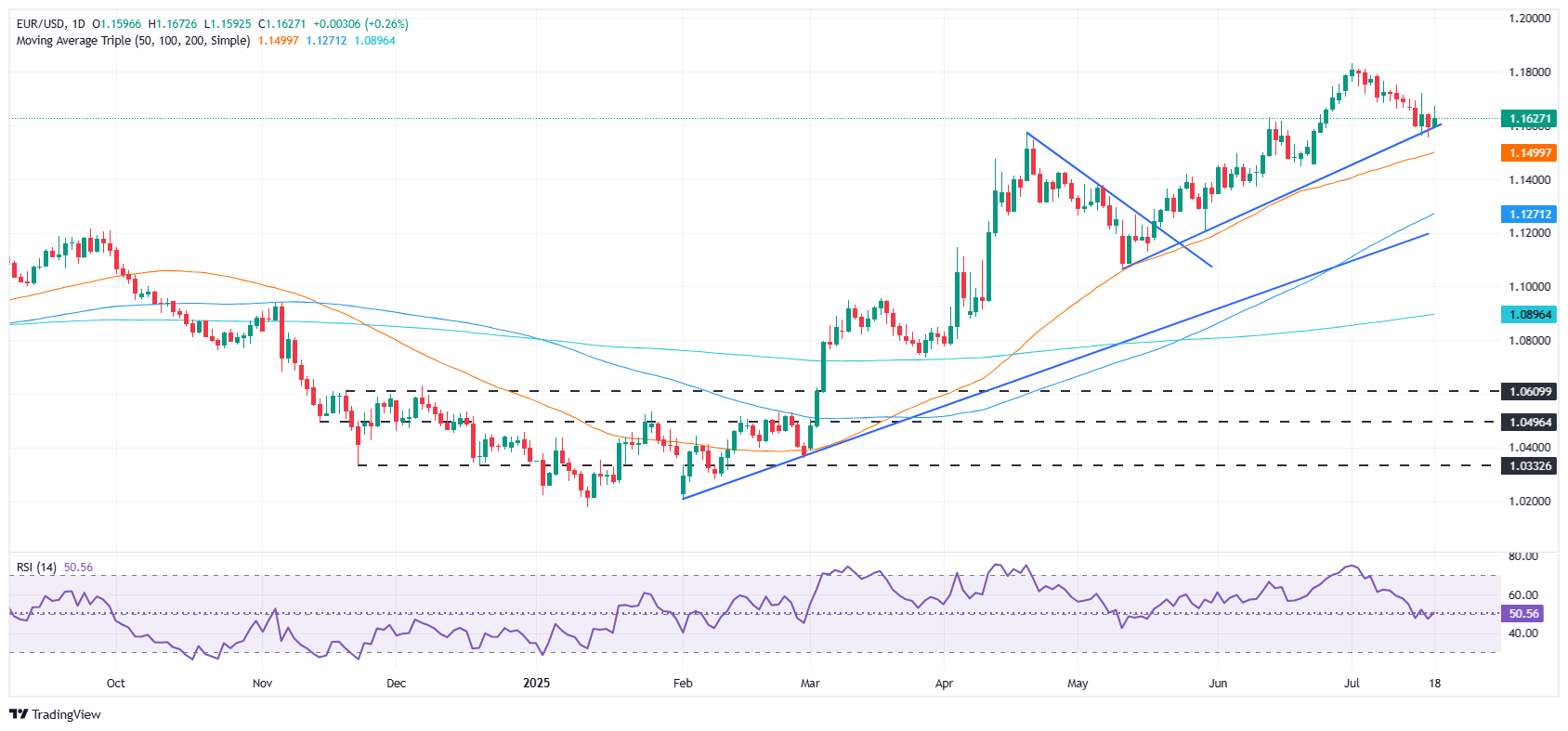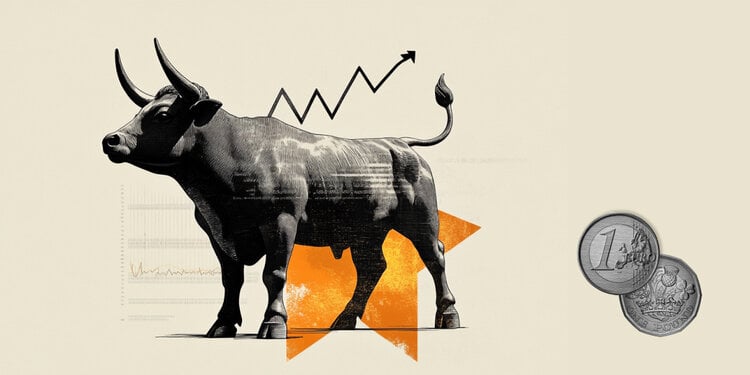- Waller of the Fed supports a rate cut in July, dragging the yields of the treasure and the dollar.
- The UOM survey shows an improved feeling and expectations of descent inflation in the US.
- ECB, EU PMIS decision and US macro data in the focus for next week.
The EUR/USD ended Friday’s session with profits of more than 0.26% in the middle of a weakest US dollar, after the moderate comments of the governor of the Fed, Christopher Waller, who weighed on the yields of the US treasure.
Wall Street closed the session in a higher tone, since investors applauded Waller’s comments, who favors a rate cut in July. In spite of this, the recent comments of the president of the Fed of Chicago, Austen Goolsbee, showed that he has moderated his dovish position, stating that it is cautious due to the last report of the CPI, which shows the first signs of tariffs that raise the inflation of goods.
In the data front, the feeling of the consumer of the University of Michigan (UOM) in July showed that households became optimistic about their financial situation and also expect inflation to decrease. Apart from this, housing data also showed signs of improvement, since the European economic agenda remained scarce, with investors looking for clues about a commercial agreement between the European Union (EU) and the United States (USA).
Next week, the EU economic agenda will include consumer confidence, the Julio PMIS and the monetary policy decision of the European Central Bank (ECB). On the other side of the Atlantic, the US calendar will announce housing data, the preliminary PMIS of Global S&P, the initial applications of unemployment subsidy and the requests for lasting goods.
Daily summary of market movements: EUR/USD recovers 1,1600 despite the solid US data.
- The preliminary feeling of the consumer of the University of Michigan rose to 61.8 in July, from 60.7 in June and slightly above the expected reading of 61.5. Joanne Hsu, director of the survey, said: “It is unlikely that consumers recover their confidence in the economy unless they feel sure that inflation will not get worse, for example, if the commercial policy is stabilized in the predictable future.”
- The Michigan University Survey also showed a decrease in inflation expectations. Long -term inflation (5 -year perspective) was reviewed down 3.6% from 4%, while one -year expectations fell to 4.4% from the previous 5%.
- Separately, the governor of the Fed, Christopher Waller, acknowledged that, although the labor market is still stable in general, the conditions in the private sector are less robust. Although he expressed his support for a possible rate cut in July, he emphasized that he did not compromise before the meeting, stating that he prefers to “listen to all the parties” before making a final decision.
- Chicago Fed President Austan Goolsbee said that the new tariffs does not help fight inflation, so they could understand the impact on prices. Although it favors rates cuts, he said they must wait longer to adjust the policy if price pressures increase.
- The recent US economic data painted a mixed inflation panorama. While the consumer price index (CPI) approached the 3%brand, the production price index (IPP) showed signs of relief. However, the strongest retail sales suggested that much of the increase was driven by higher prices linked to freshly tax tariffs, instead of the underlying demand.
- Since last week, several ECB policies have expressed their opinions on monetary policy perspectives. Mario Centeno joined De Guindos, Vujčić and Villery to point out his support for a pause or a possible rate cut. Fabio Panetta also supported relief, citing growing risks for growth.
- In contrast, Isabel Schnabel argued that current rates are properly positioned, advocating them – a opinion backed by Robert Holzmann, who emphasized the need to expect more data before making adjustments.
EUR/USD Technical Perspective: It is consolidated between the 20 and 50 days SMA, above 1,1600
The EUR/USD is quoting laterally, despite having an upward trend from a market structure perspective. However, the Relative Force Index (RSI) indicates bassism, suggesting that neither buyers nor sellers are in control.
Therefore, if the EUR/USD exceeds 1,1650, this would clear the way to test the single mobile (SMA) of 20 days in 1,1692. Once overcome, the following objectives would be 1,1700 and 1,1800.
On the other hand, if the EUR/USD falls below 1,1600, the next support level would be the 1,1550 mark, followed by the 50 -day SMA in 1,1497. Once these demand areas have been exceeded, the next line of defense for the bullies would be the 100 -day SMA in 1,1266.

EURO – FREQUENT QUESTIONS
The euro is the currency of the 19 countries of the European Union that belong to the Eurozone. It is the second most negotiated currency in the world, behind the US dollar. In 2022, it represented 31 % of all foreign exchange transactions, with an average daily business volume of more than 2.2 billion dollars a day. The EUR/USD is the most negotiated currency pair in the world, with an estimate of 30 %of all transactions, followed by the EUR/JPY (4 %), the EUR/GBP (3 %) and the EUR/AU (2 %).
The European Central Bank (ECB), based in Frankfurt (Germany), is the Eurozone reserve bank. The ECB establishes interest rates and manages monetary policy. The main mandate of the ECB is to maintain price stability, which means controlling inflation or stimulating growth. Its main tool is the rise or decrease in interest rates. Relatively high interest rates (or the expectation of higher types) usually benefit the euro and vice versa. The GOVERNMENT BOOK of the ECB makes decisions about monetary policy in meetings that are held eight times a year. The decisions are made by the directors of the National Banks of the Eurozone and six permanent members, including the president of the ECB, Christine Lagarde.
Eurozone inflation data, measured by the harmonized consumer prices index (IPCA), are an important economic indicator for the euro. If inflation increases more than expected, especially if it exceeds 2% of the ECB, it forces the ECB to rise interest rates to control it again. Relatively high interest rates compared to their counterparts usually benefit the euro, since they make the region more attractive as a place for global investors to deposit their money.
Published data measure the health of the economy and can have an impact on the euro. Indicators such as GDP, manufacturing and services PMIs, employment and consumer trust surveys can influence the direction of the single currency. A strong economy is good for the euro. Not only attracts more foreign investment, but it can encourage the ECB to raise interest rates, which will directly strengthen the euro. Otherwise, if economic data is weak, the euro is likely to fall. The economic data of the four largest economies in the euro zone (Germany, France, Italy and Spain) are especially significant, since they represent 75% of the economy of the euro area.
Another important fact that is published on the euro is the commercial balance. This indicator measures the difference between what a country earns with its exports and what you spend on imports during a given period. If a country produces highly demanded export products, its currency will gain value simply by the additional demand created by foreign buyers seeking to buy those goods. Therefore, a positive net trade balance strengthens a currency and vice versa in the case of a negative balance
Source: Fx Street
I am Joshua Winder, a senior-level journalist and editor at World Stock Market. I specialize in covering news related to the stock market and economic trends. With more than 8 years of experience in this field, I have become an expert in financial reporting.







